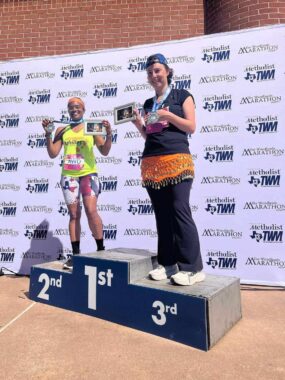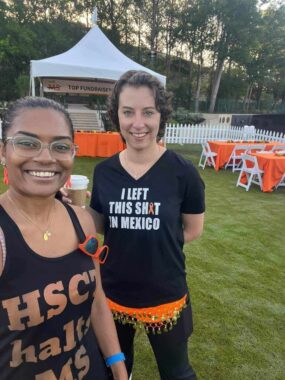How an MS friendship led to HSCT and a love of running
Written by |


Amanda Olivier, left, and Sagirah Ahmed Norris pose with their medals at the Athletes with Disabilities Half Marathon in The Woodlands, Texas, in 2023. (Photos courtesy of Amanda Olivier and Sagirah Ahmed Norris)
Day 8 of 31
This is Amanda Olivier and Sagirah Ahmed Norris’ story:
AO: I awoke in October 2020 with a tight squeezing sensation in my rib cage. Alarm bells went off in my head. I knew something was seriously wrong. Months passed and the tightness in my chest didn’t go away. A trip to the neurologist and a few MRIs later, I was diagnosed with relapsing-remitting multiple sclerosis (RRMS) in January 2021.

Ahmed Norris, left, places second and Olivier places third at the Athletes With Disabilities Half Marathon.
I was prescribed a disease-modifying therapy (DMT) and took it from May to June of 2021, but I continued to feel increasingly sick, nauseated, numb, and dizzy. My neurologist suggested the MS Gym website for exercises that would help me gain and retain strength.
While perusing the site, I found others with MS thriving after undergoing hematopoietic stem cell transplantation (HSCT). This procedure involves wiping out a patient’s faulty immune system with chemotherapy, and then “rebooting” it using stem cells harvested from blood or bone marrow.
Eventually, someone suggested that I connect with Sagirah Ahmed Norris because we both lived in Houston.
Sagirah, who lives only 3 miles from me, has primary progressive multiple sclerosis (PPMS) and had HSCT in January 2020. We met up for lunch in June 2021. After witnessing Sagirah’s agility and vibrancy and watching her train for the Boston Marathon, my husband, Jeremy, and I headed to Clínica Ruiz in Monterrey, Mexico, in October 2021 for me to undergo HSCT.
Running after HSCT
Sagirah decided to run her first marathon in 2017. While running the Chicago Marathon, her body went numb and she struggled to lift her foot. Believing she’d injured herself during the race, Sagirah sought out treatment from a sports doctor, who sent her in for MRIs. She was directed to see a neurologist, where she learned that she had PPMS.
Despite quickly being put on a DMT, Sagirah continued to decline. She was using a cane and, at times, a wheelchair for mobility due to severe foot drop, left-side neuropathy, and tremors. Determined to travel before MS made it more difficult, Sagirah set out on her bucket list trips.
After learning about HSCT, Sagirah packed her bags in January 2020 and headed to Clínica Ruiz in Puebla, Mexico. After receiving the transplant, and with the help of physical therapy, she began running marathons again. She has since donated her cane to her mother.

Ahmed Norris, left, and Olivier at an MS fundraising event.
After completing the 28-day HSCT procedure, I joined Houston’s West End Running Club to exercise and socialize with friends on Tuesdays. With Sagirah’s encouragement, I began training for my first half-marathon, which I completed in March 2023.
Sagirah became the first person with PPMS to complete the Abbott World Marathon Majors, which is comprised of six marathons (Toyko, Berlin, Boston, Chicago, New York City, and London). She completed her last one in Tokyo on March 2.
We want everyone with MS to have the opportunity to live their best lives, too. Knowing that there’s an effective treatment available that can potentially halt this disease in its tracks has been a blessing. Since undergoing HSCT, we no longer fear for our future selves, but embrace life and all it has to offer.
In recognition of Multiple Sclerosis Awareness Month in March, the MS Community Spotlight campaign features a series of stories highlighting the real-life experiences of people affected by MS, written in their own words. Follow us on Facebook, Instagram, and Pinterest for more stories like this, using the hashtag #MSSpotlight, or read the full series.





